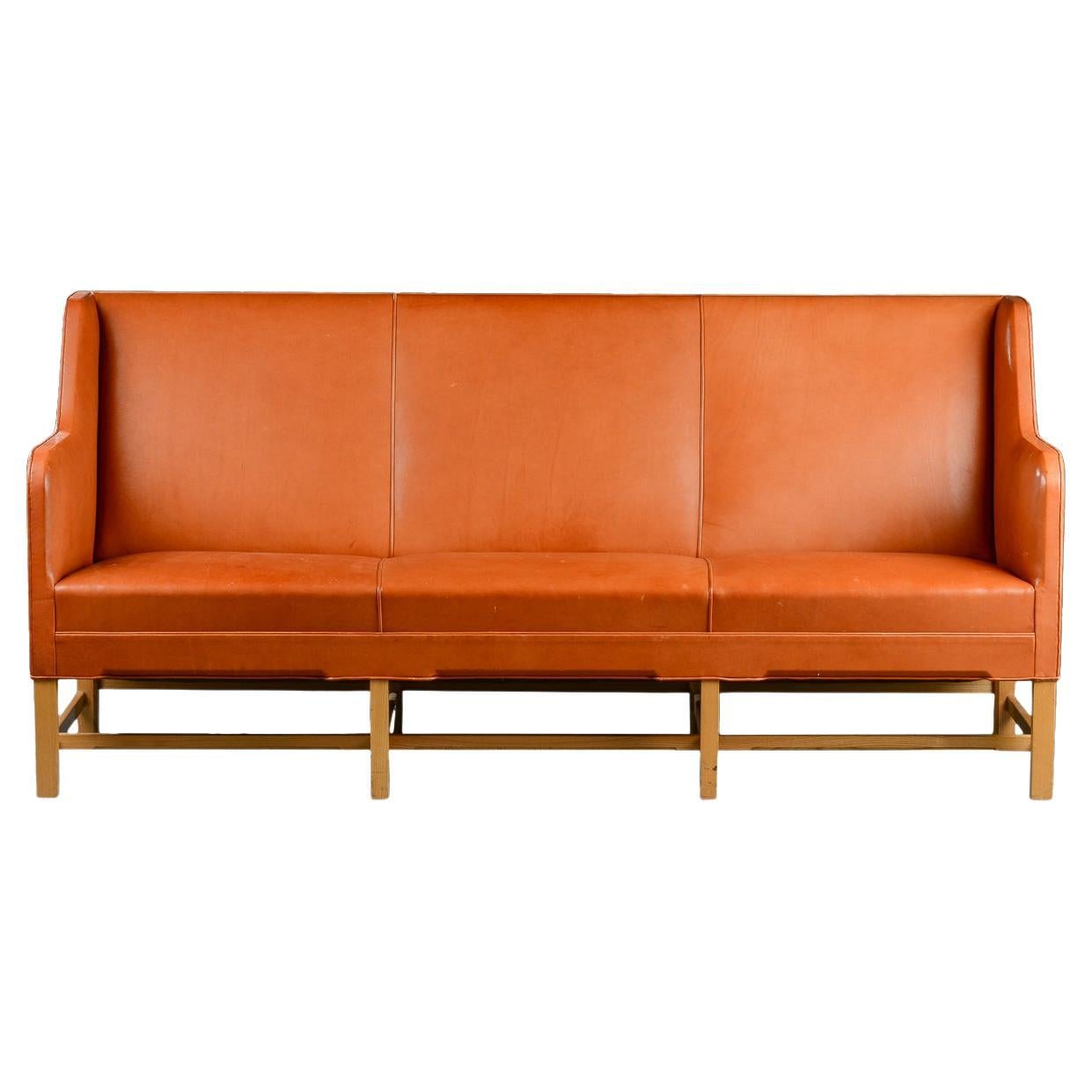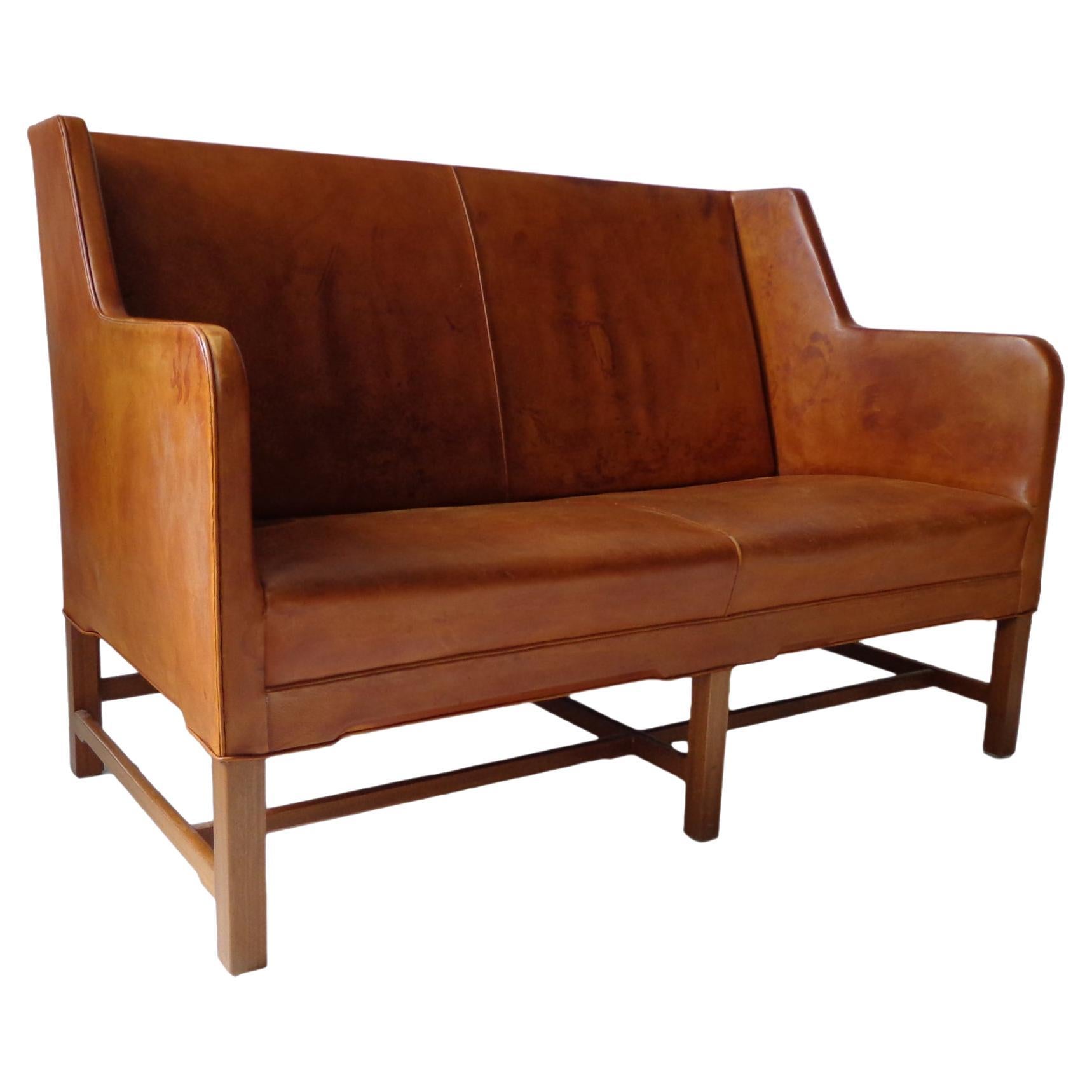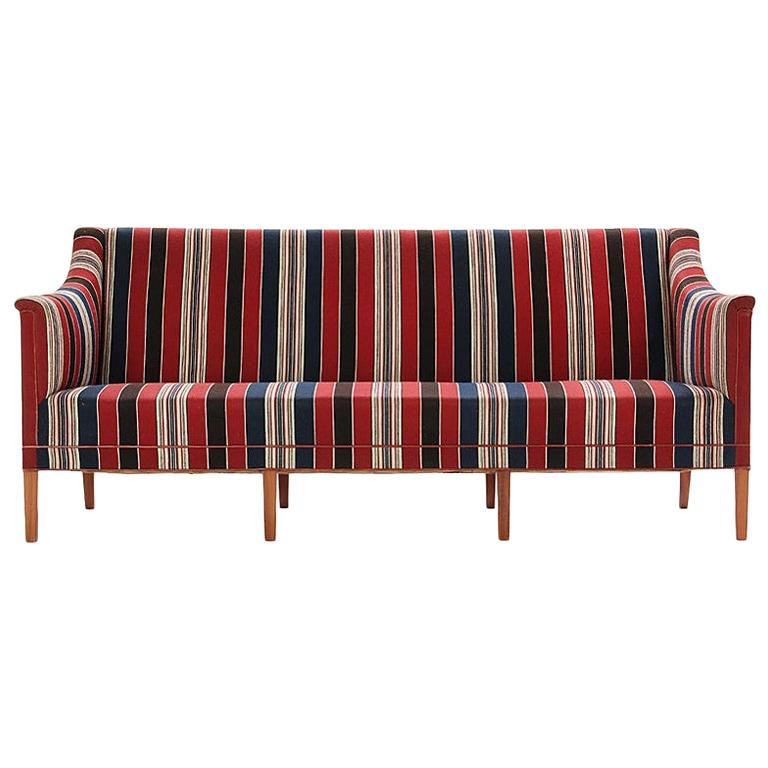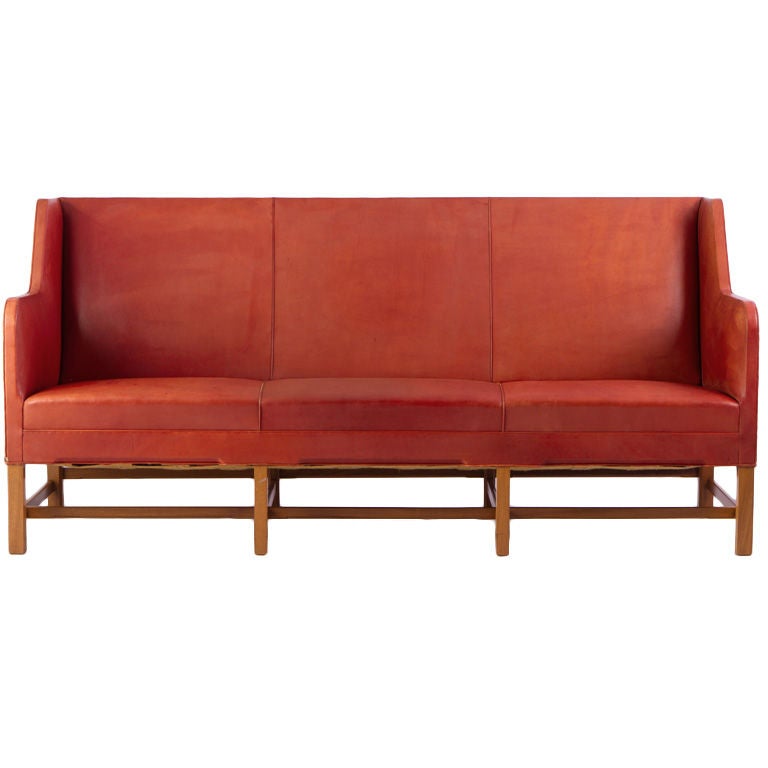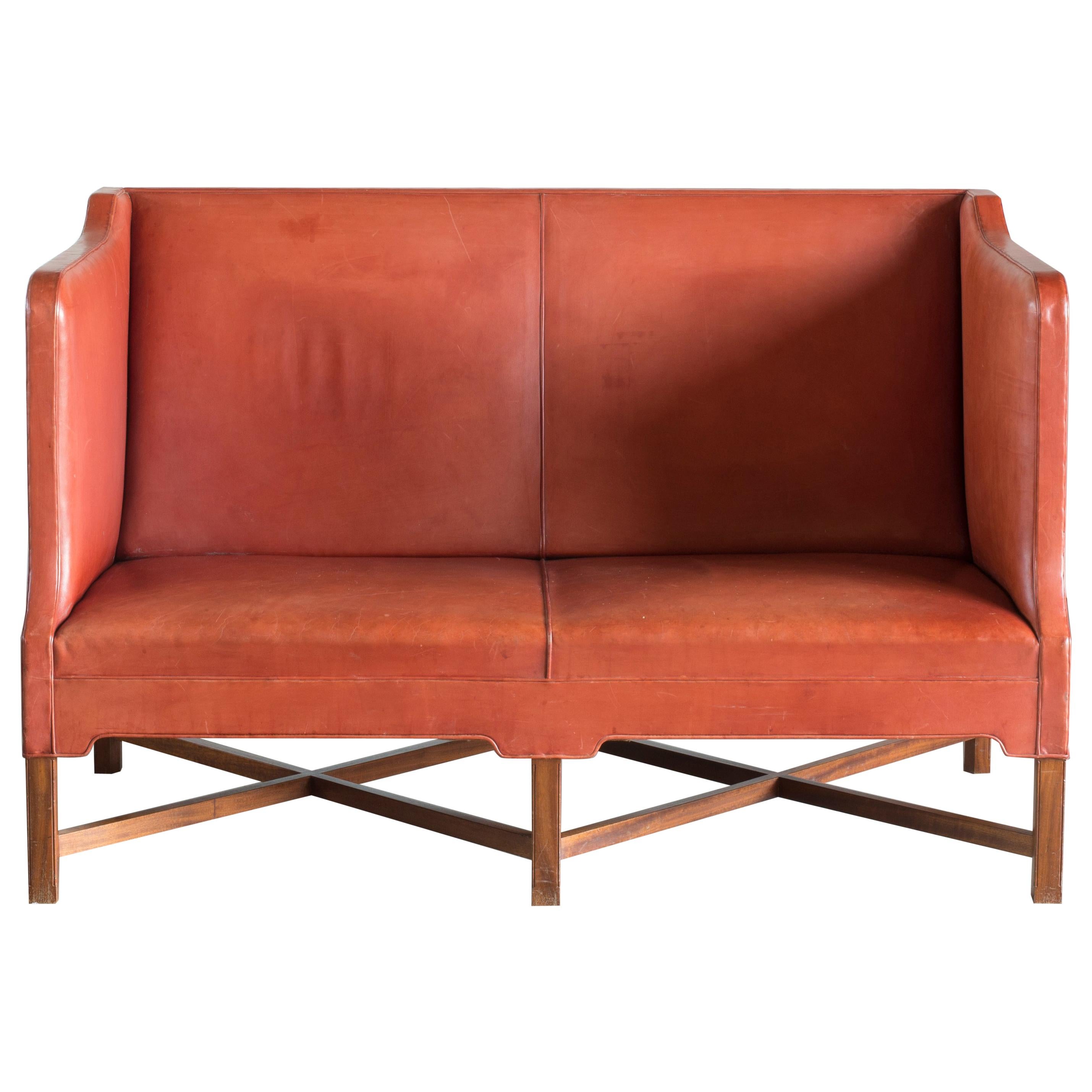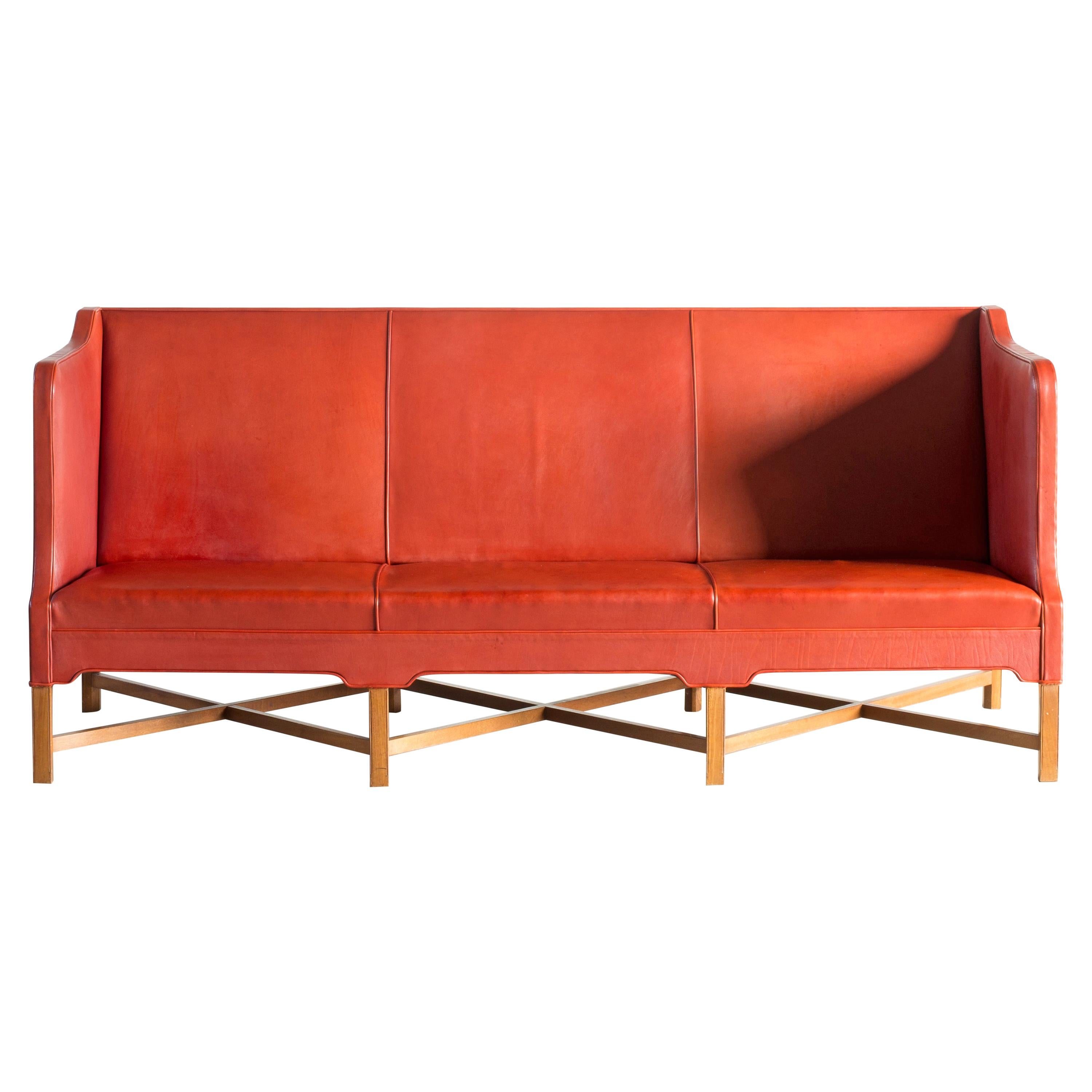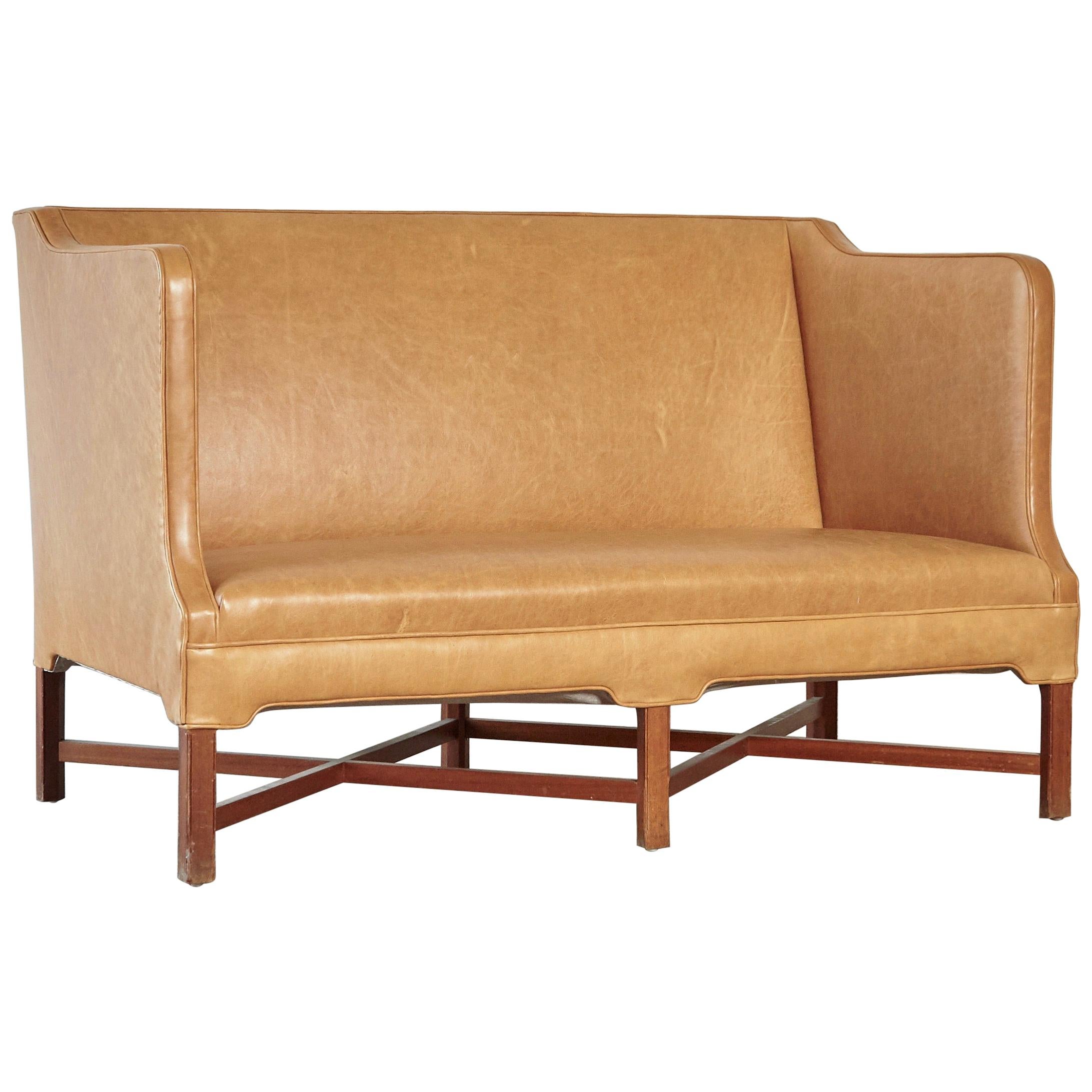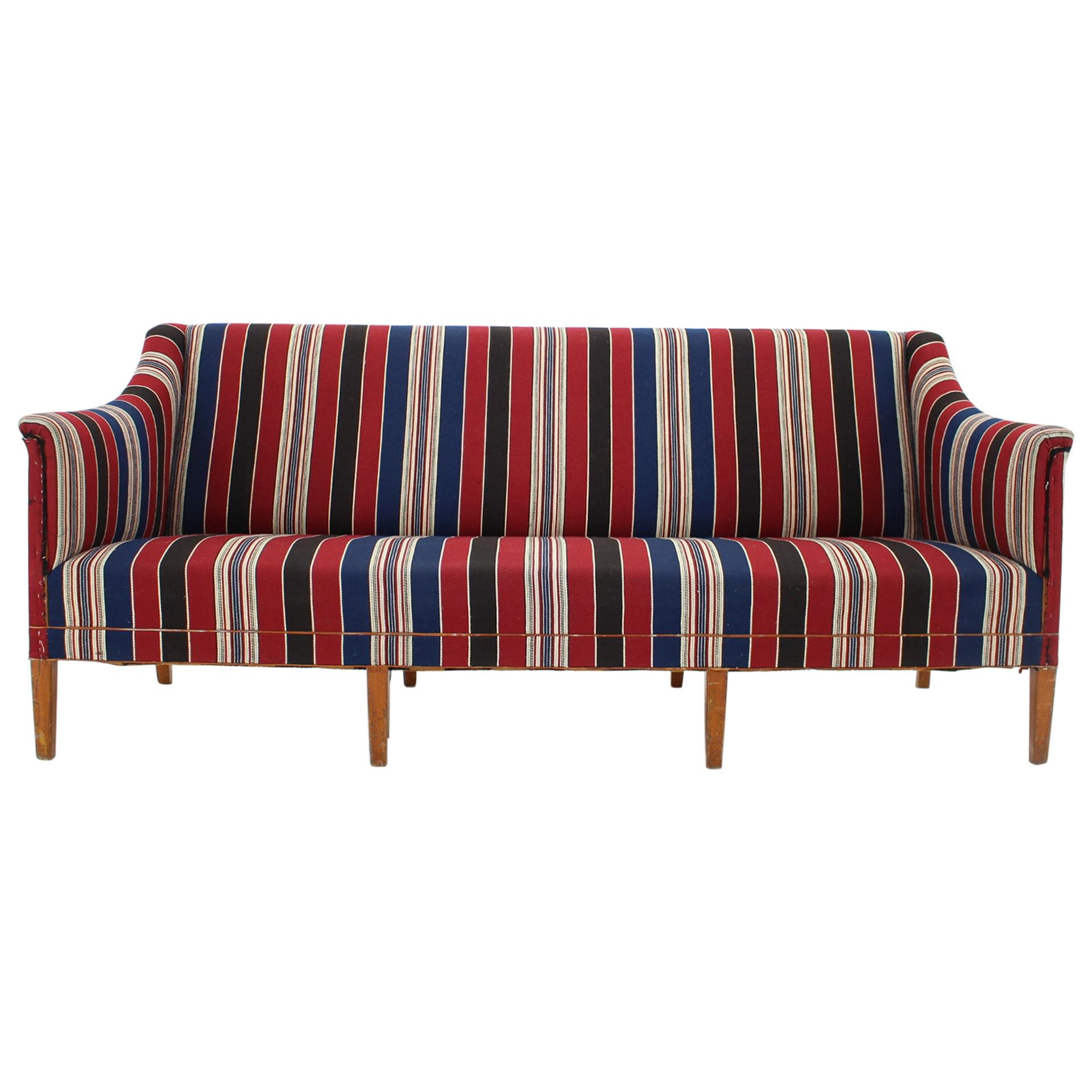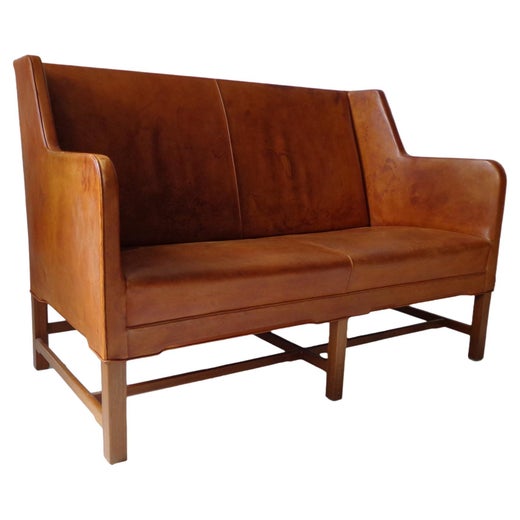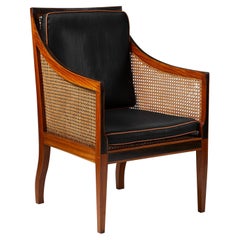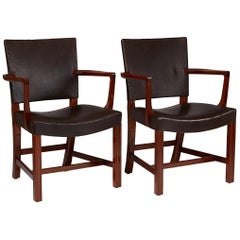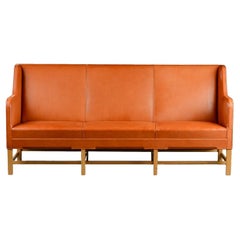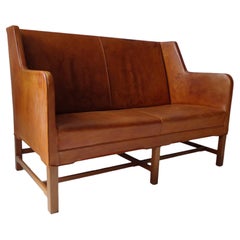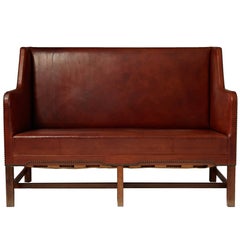
Sofa Model 5011 Designed by Kaare Klint for Rud Rasmussen, Denmark, 1935
View Similar Items
Sofa Model 5011 Designed by Kaare Klint for Rud Rasmussen, Denmark, 1935
About the Item
- Creator:Kaare Klint (Designer)
- Dimensions:Height: 36.23 in (92 cm)Width: 51.97 in (132 cm)Depth: 25.79 in (65.5 cm)
- Style:Scandinavian Modern (Of the Period)
- Materials and Techniques:
- Place of Origin:
- Period:
- Date of Manufacture:1935
- Condition:
- Seller Location:Stockholm, SE
- Reference Number:1stDibs: LU100664018753
Kaare Klint
Architect, teacher and furniture designer Kaare Klint is among the most important figures in Scandinavian modernism. Widely recognized as the father of modern Danish furniture, Klint sought to pay homage to historical furniture styles and prized functionality as essential to designing for modern living. He established the design school at Copenhagen’s Royal Danish Academy of Fine Arts, and his students became mid-century legends of cabinetry and furniture-making.
Klint prioritized functionalism and drew on an array of influences in his own work. Furniture experts will observe the influence of 18th-century English seating in his Red chair, while Klint’s iconic Safari chair had roots in campaign furniture. The other exemplary chairs, sofas and tables for which he is known bear the mark of Thomas Chippendale and Biedermeier furniture as well as Greek and Roman forms.
Klint's father was Peder Vilhelm Jensen-Klint, a formidable architect of his day. The younger Klint initially followed in his father’s footsteps, studying under him as well as distinguished architect Carl Petersen. Alongside Danish architect Ivar Bentsen, he headed the renovation of the Designmuseum Denmark in Copenhagen from 1920–26 (Klint also furnished the institution as part of the project). Around the same time, Klint helped found the furniture design school at the Royal Danish Academy. The impact of his role as an instructor there cannot be overstated — he mentored such esteemed cabinetmakers and furniture designers as Børge Mogensen, Hans Wegner and Ole Wanscher.
A prominent advocate of ergonomics, Klint valued comfort and functionality over style. Painstaking research went into each piece of sophisticated yet wholly unadorned furniture he designed, as he endeavored to build structures that took into consideration human proportions and scale. And like the Shakers, Klint believed that quality craftsmanship and good materials were integral to the design of durable furniture that was free of embellishment.
The humble grace of Klint’s style characterizes legendary seating designs that continue to charm today’s legions of mid-century modern enthusiasts. His Safari chair, Faaborg chair, Ravenna armchair and Propeller stool — as well as most of the seating created by Danish modernists generally — have warmed interiors and influenced furniture designers all over the world.
Find vintage Kaare Klint furniture and other Scandinavian modern furniture on 1stDibs.
- Armchair Model 4488 Designed by Kaare Klint for Rud. Rasmussen, Denmark, 1930sBy Kaare KlintLocated in Stockholm, SEArmchair model 4488 designed by Kaare Klint for Rud. Rasmussen, Denmark, 1930s. Mahogany, ebony, cane, and black horsehair upholstery with cognac leather piping. Klint thought...Category
Vintage 1930s Danish Mid-Century Modern Armchairs
MaterialsLeather, Cane, Ebony, Mahogany
- Pair of Armchairs Model 3758 a Designed by Kaare Klint for Rud. RasmussenBy Kaare KlintLocated in Stockholm, SEPair of armchairs model 3758 A designed by Kaare Klint for Rud. Rasmussen, Denmark. 1927. Mahogany and leather. Model designed in 1927 for the Danish Museum of Decorative Art prod...Category
Vintage 1920s Danish Scandinavian Modern Armchairs
MaterialsLeather, Mahogany
- Armchair ‘The Red Chair’ Model 3758a Designed by Kaare Klint for Rud, RasmussenBy Kaare KlintLocated in Stockholm, SEArmchair ‘The Red Chair’ Model 3758A designed by Kaare Klint for Rud. Rasmussen, Denmark, 1930s. Mahogany, leather upholstery, and brass. This example was produced after 1930. The design detailing of this magnificent chair...Category
Vintage 1930s Danish Mid-Century Modern Armchairs
MaterialsBrass
- ‘The Faaborg Chair’ designed by Kaare Klint for Rud. Rasmussen CabinetmakersBy Kaare KlintLocated in Stockholm, SE‘The Faaborg Chair’ designed by Kaare Klint for Rud. Rasmussen Cabinetmakers Denmark, 1914. Mahogany, woven cane and leather. Designed in 1914 for the Faaborg Museum. This example w...Category
Vintage 1910s Danish Mid-Century Modern Chairs
MaterialsLeather, Cane, Mahogany
- ‘The Faaborg Chair’ designed by Kaare Klint for Rud. Rasmussen CabinetmakersBy Kaare KlintLocated in Stockholm, SEThe Faaborg Chair’ designed by Kaare Klint for Rud. Rasmussen Cabinetmakers Denmark, 1914. Mahogany, woven cane, and leather. Designed in 1914 for the Faaborg Museum. This example ...Category
Vintage 1910s Danish Chairs
MaterialsLeather, Cane, Mahogany
- Pair of Armchairs “The Red Chair” Designed by Kaare Klint for Rud. RasmussenBy Kaare KlintLocated in Stockholm, SEPair of armchairs “The Red Chair” designed by Kaare Klint for Rud. Rasmussen, Denmark, 1930. Oak, leather upholstery and brass. Stamped ‘RUD. RASMUSSENS SNEDKERIER 45 NORREBROGADE KOBENHAVN’ Literature: Gorm Harkær, Klintiana: “Kaare Klint”, vol. 2, ill. and mentioned p. 79–80. The design detailing of these magnificent chairs...Category
Early 20th Century Swedish Mid-Century Modern Armchairs
MaterialsBrass
- Kaare Klint Sofa Model 5011 Original Cognac Leather for Rud Rasmussen DenmarkBy Rud Rasmussen, Kaare KlintLocated in WIJCKEL, NLThree-seater sofa model 5011 in original leather and eight-legged ash base. Produced by Rud. Rasmussen Cabinetmakers, Denmark. Minor marks on the frame, patina to the leather. Shown at the Copenhagen Cabinetmakers’ Guild exhibition in 1935. Kaare Klint is widely recognized as the father of Danish modern design. It is hard to overstate his influence. He developed an entirely new analytical approach to furniture design that his students at the Danish Academy of Art would emulate for years to come, yet was also inspired by historic designs from various cultures, modernizing and re-interpreting classic pieces for new generations. Literature: Gorm Harkær, Klintiana: “Kaare Klint”, vol.2, pg 94. Kaare Klint (1888-1954) is regarded as the founding father of Danish Modernim. As an architect, furniture designer and leading professor at the Department of Furniture Design at the Royal Danish Academy of Fine Arts, Copenhagen, Klint established the principles of modern Danish furniture by combining a profound appreciation of traditional construction techniques with a modernist emphasis on function and a rejection of ornaments. Klint’s design was always based on relentless research; he never compromised. Every piece had to fulfill its purpose, be completely clear in its construction with dimensions and proportions corresponding to the human body and display materials and craftsmanship of the highest quality. Logic, often using a mathematical system of measures, and a constructive way of thinking were the foundation of Klint’s philosophy of furniture design. Like many of his contemporaries, counting Le Corbusier and Walter Gropius, he advocated standardization and functional requirements and dismissed the use of all ornamentation. But Klint realized his vision in wood and leather, using traditional craftsmen and working methods and often finding inspiration in historical models. In this way, he charted the course for an alternative Nordic Functionalism that idealized the workshop and the collaboration between furniture architects and cabinetmakers as opposed to the factory. Kaare Klint’s first major work was a collaboration with his mentor, the architect Carl Petersen. In 1914 they were commissioned to design furniture and fixtures for Faaborg Art Museum. One of the highlights to emerge from this commission was the Faaborg chair, a light and elegant chair with clear references to classical furniture. The construction and proportions of an 18th century English Chippendale...Category
Vintage 1970s Danish Scandinavian Modern Sofas
MaterialsLeather, Ash
- Kaare Klint Sofa Model 5011 in Original Cognac Leather Rud Rasmussen, DenmarkBy Rud Rasmussen, Kaare KlintLocated in WIJCKEL, NLTwo-seater sofa model 5011 in original cognac leather and six-legged mahogany base. Produced by Rud. Rasmussen Cabinetmakers, Denmark. Minor marks on the frame, patina to the leather. Back covered in original canvas. Shown at the Copenhagen Cabinetmakers’ Guild exhibition in 1935. Signed with decal manufacturer’s label to underside: (Rud. Rasmussens Snedkerier). Kaare Klint is widely recognized as the father of Danish modern design. It is hard to overstate his influence. He developed an entirely new analytical approach to furniture design that his students at the Danish Academy of Art would emulate for years to come, yet was also inspired by historic designs from various cultures, modernizing and re-interpreting classic pieces for new generations. Literature: Gorm Harkær, Klintiana: “Kaare Klint”, vol.2, pg 94. Kaare Klint (1888-1954) is regarded as the founding father of Danish Modernim. As an architect, furniture designer and leading professor at the Department of Furniture Design at the Royal Danish Academy of Fine Arts, Copenhagen, Klint established the principles of modern Danish furniture by combining a profound appreciation of traditional construction techniques with a modernist emphasis on function and a rejection of ornaments. Klint’s design was always based on relentless research; he never compromised. Every piece had to fulfill its purpose, be completely clear in its construction with dimensions and proportions corresponding to the human body and display materials and craftsmanship of the highest quality. Logic, often using a mathematical system of measures, and a constructive way of thinking were the foundation of Klint’s philosophy of furniture design. Like many of his contemporaries, counting Le Corbusier and Walter Gropius, he advocated standardization and functional requirements and dismissed the use of all ornamentation. But Klint realized his vision in wood and leather, using traditional craftsmen and working methods and often finding inspiration in historical models. In this way, he charted the course for an alternative Nordic Functionalism that idealized the workshop and the collaboration between furniture architects and cabinetmakers as opposed to the factory. Kaare Klint’s first major work was a collaboration with his mentor, the architect Carl Petersen. In 1914 they were commissioned to design furniture and fixtures for Faaborg Art Museum. One of the highlights to emerge from this commission was the Faaborg chair, a light and elegant chair with clear references to classical furniture. The construction and proportions of an 18th century English Chippendale chair...Category
Vintage 1940s Danish Scandinavian Modern Sofas
MaterialsLeather, Mahogany
- 1960s Danish Sculpted Sofa by Kaare Klint for Rud RasmussenBy Kaare Klint, Rud RasmussenLocated in Sagaponack, NYA majestic sofa having a sculptured body resting on eight (8) tapered mahogany legs, retaining the original red, navy and beige striped wool fabric. Desi...Category
Vintage 1940s Danish Scandinavian Modern Sofas
MaterialsUpholstery, Mahogany
- Kaare Klint Sofa by Rud RasmussenBy Kaare KlintLocated in Pawtucket, RIKaare Klint three-seat sofa in original leather on a Cuban mahogany frame and produced by cabinetmaker Rud Rasmussen.Category
Vintage 1930s Danish Sofas
MaterialsLeather, Mahogany
- Vintage two-seater Sofa by Kaare Klint for Rud. Rasmussen 1935sBy Rud Rasmussen, Kaare KlintLocated in Lejre, DKThe vintage design two-seater sofa model 5011 created by Kaare Klint. This iconic piece is crafted in original cognac leather and features a distinctive six-legged mahogany base. The...Category
Vintage 1930s Danish Mid-Century Modern Sofas
MaterialsLeather, Mahogany
- Kaare Klint Two-Seat Sofa for Rud. RasmussenBy Rud Rasmussen, Kaare KlintLocated in Copenhagen, DKKaare Klint freestanding two-seat sofa on six-legged, profiled mahogany cross-frame. Sides, seat and back upholstered with patinated leather. Executed by Rud. Rasmussen, Copenhagen. ...Category
Mid-20th Century Danish Scandinavian Modern Sofas
MaterialsLeather, Mahogany
